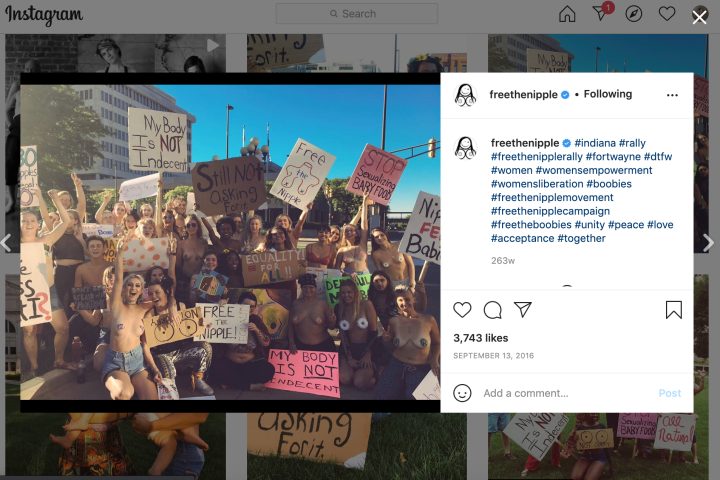
“Free the nipple” has made headlines yet again, this time over Instagram’s public apology to director Pedro Almodovar for censoring the poster for his latest movie Madres Paralelas. The image, designed by artist Javier Jaen, features a lactating nipple cropped to appear as a crying eye, and it was widely removed on the platform for violating Instagram’s guidelines. The apology issued by Instagram resulted in Almodovar proclaiming victory over the algorithm, and an abundance of media attention including the New York Times’s article.
The body-equality slogan “Free the nipple” is so ubiquitous that it sounds as though it belongs in the annals of history alongside “Make love not war” and “Votes for women,” but actually this international rallying cry is barely a decade old. Born into the Instagram-age and made infamous through it, “Free the nipple” has regularly popped up on social media accounts, despite the fact that #FreeTheNipple itself is invisible on the platform: Type in “#FreeTheNipple” in the Instagram search bar and it will direct to a stark notice: “This Hashtag Is Hidden.” Alternatively, add a year to the slogan such as #freethenipple2021 and it works, effectively rendering the movement a yearly trend rather than the full-voiced campaign for change that it is.
In 2012, director Lina Esco filmed the movie Free The Nipple which followed a fictional group of young women exposing the double-standard and protesting for equality. The movie was set in New York City and staged real-life protests during production — pink balaclava-clad women running through Times Square topless, dodging police and wheat pasting “Free the nipple” posters on walls. There were actual arrests; there was media coverage; and #FreeTheNipple was born.
The ties between Hollywood and freeing the nipple run deep. In 1934 Clark Gable created a stir when he went shirtless in the movie It Happened One Night. That same year, four men were arrested in Coney Island for going topless at the beach — charged with disorderly conduct and fined one dollar each. More public protests followed, eventually resulting in New York City giving in to public pressure and changing their laws to allow men to go topless. In the 1980s, more protests extended the law to allow women to go topless in New York as well — which is why Lina Esco chose NYC as the location to shoot her film, where being topless is legal despite the harassment she and her cast endured during filming.
While the movie itself encountered serious obstacles from production through distribution, the phrase which was to be printed across theater marquees instead became a viral hashtag used by influential personalities to protest social media censorship of the female-presenting body.
Miley Cyrus posted a topless photo sporting the #FreeTheNipple tag which was immediately removed by Instagram. Scout Willis went shopping in New York topless and posted it to social media, captioning her errands “Legal in New York, but not on Instagram.”
Soon “Free the Nipple” protests went international. In 2015, after being harassed online for posting a topless photo, 17-year-old Adda Smaradottir received a swell of support from her country of Iceland. The day after she posted about the incident, women and allies went topless all over the country, including a member of government, all using the hashtag #FreeTheNipple in their social media posts.
That same year five women in Taipei staged their own, private “Free the Nipple” protest. They posted images from this event online and were immediately shamed by their community, and the images were deleted by Facebook.
“Free the Nipple” groups have sprung up around the world. In 2016, a “Free the Nipple Brighton” annual march was kicked off, and two members of “Free the Nipple New Hampshire” were fined for doing topless yoga on a beach.

In 2019 the “Free the Nipple Fort Collins” association filed a federal lawsuit and won, effectively giving women the right to go topless in Wyoming, Utah, Colorado, New Mexico, Kansas, and Oklahoma. This year a “Free the Nipple” group has unsuccessfully sued Ocean City, Maryland’s restriction on exposed female breasts.
“Free the Nipple” is the viral slogan which brought together artists, activists and advocates from around the world, pointing out the double standard many of us deal with daily. The ubiquity of its presence in our society should emphasize the continued need for it.
While court cases have helped to shape this movement from the 1930s until today, the social-media landscape has generally remained deaf to calls for change.
Instagram’s apology to Almodovar was recently hailed a win for the movement, but ask artists and activists on Instagram about this and the reality of the situation is far different. Besides the hidden #FreeTheNipple hashtag, artists and activists who align with the “Free the nipple” ethos have experienced an increase in post deletion and account disabling by the social media giant in the wake of that public apology.
Savannah Spirit, curator for the Don’t Delete Art campaign which partners with international advocacy groups to highlight art censorship on social media, states: “It seems suspicious that after Instagram’s apology to Almodovar, artists, models and people posting work about the body have been feeling a more rigorous crackdown on deletions and entire profiles erased.”
If Instagram’s apology is sincere, then it is time for them to reevaluate their policies, which not only curtail artistic expression, but maintain the double-standard “Free the Nipple” is fighting against. From the very start “Free the Nipple” was the powerful call for change we need, and by denying us use of the #FreeTheNipple hashtag they are only proving how needed it is.
0 Commentaires